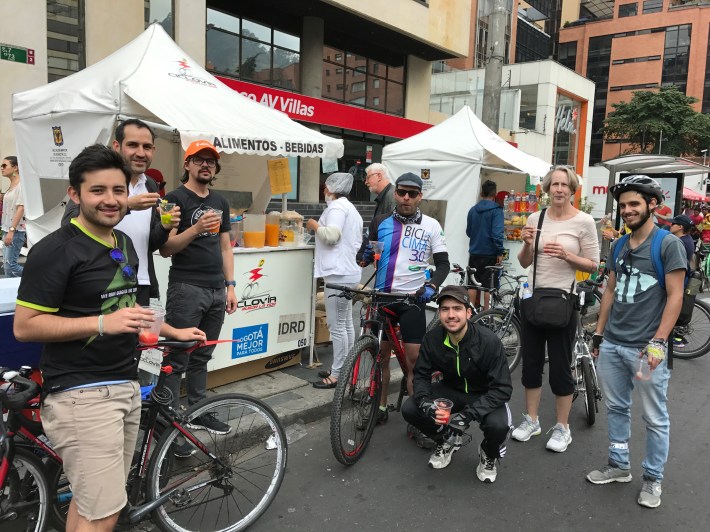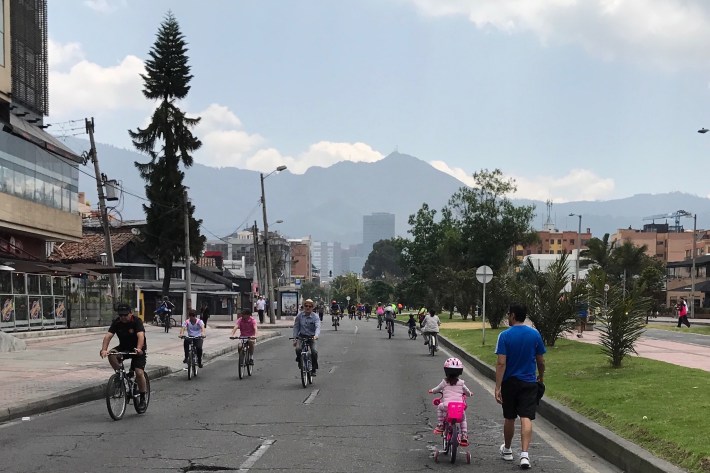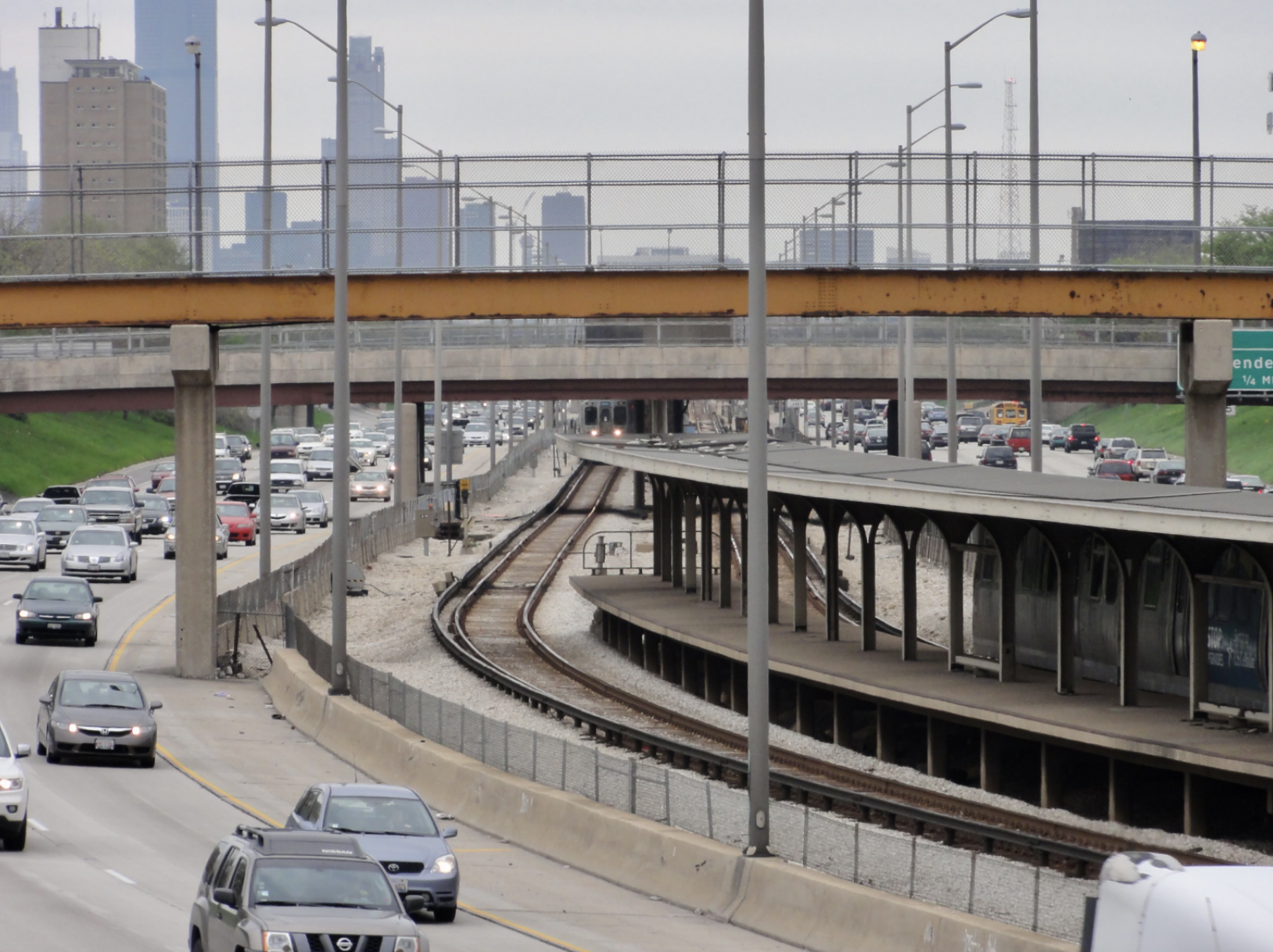Colombia College: Lessons From Bogotá’s Transportation System for Chicago
2:06 PM CST on March 9, 2017

A TransMilenio station. Photo: John Greenfield
[The Chicago Reader publishes a weekly transportation column written by Streetsblog Chicago editor John Greenfield. We syndicate the column on Streetsblog after it comes out online.]
Last month I visited Bogotá, Colombia, a destination that's been on my bucket list for a long time. In recent years the formerly crime-ridden and civil war-torn capital has made a remarkable turnaround: As recently detailed by Chicago magazine's Whet Moser, Bogota has succeeded in lowering its homicide rate by more than 75 percent since 1993. During my stay in the city nicknamed the South American Athens, I was impressed by its many excellent museums, centuries-old Spanish Colonial architecture, and impressive Andean setting, as well as the hospitality of its residents.
And while riding taxis through Bogotá's clogged streets was a frustrating experience, the city now also has a global reputation for progressive transportation policies, including ideas that Chicago would be wise to imitate. Specifically, the extensive TransMilenio bus rapid transit system and the Sunday Ciclovía or "cycleway" program, which opens a roughly 75-mile network of streets for car-free recreation and draws some two million people each week.
Progressive mayor Enrique Peñalosa launched TransMilenio in 2000 to combat traffic congestion and make it easier for low-income people to access jobs. The system includes 12 bus lines with 70 miles of dedicated lanes, serving 147 subway-style stations and carrying up to 2.2 million passengers a day. Peñalosa also greatly expanded the Ciclovía, which started out as a grassroots event staged by bike aficionados and has since spread to dozens of other cities around Latin America and the U.S. These Bogotá initiatives have inspired Chicago transportation advocates since 2001, when Peñalosa gave a talk at a sustainable transportation symposiumhere. But Chicago still has a ways to go to fully realize the vision already being implemented in Bogotá.
When I rode TransMilenio during my Bogotá visit, I was wowed by the system's efficiency. Unlike Chicago's downtown Loop Link corridor, TransMilenio features prepaid boarding and extralong buses with multiple doors, which means there's little "dwell time" at the stations, and there are curbs to keep private vehicles out of the bus-only lanes.
Although I'm told conditions during rush hour are beyond sardinelike, TransMilenio makes a strong argument for following through withChicago's plan for robust BRT on Ashland Avenue. That proposal was back-burnered a few years ago after fierce opposition from residents and merchants who feared reallocating street space from autos to buses would lead to carmageddon.
I was also impressed by the Sunday Ciclovía. My partner and I biked part of the route with Carlosfelipe Pardo, director of Despacio, or "Slowly," an organization that promotes livable cities. We rode down a series of multilane thoroughfares where car traffic had been banished to the other side of a grassy median. Cyclists of all ages and proclivities—from families with kids in baby seats and on training wheels to middle-aged roadies in Lycra to youthful seniors on vintage cruisers—made their way down the boulevard.
Pedestrians walking dogs, pushing baby carriages, roller skating, and skateboarding took advantage of the closed roads too, while folks relaxing on the medians and in plazas enjoyed the high-altitude sunshine. And the presence of many independent vendors selling food and drink—especially fresh-squeezed juices—made the economic benefits of the event obvious. (I recommend the lulada, a tangy punch made from the indigenous lulo fruit.)
Although each Ciclovía requires a significant investment in traffic control by the city, Pardo says the expense is worth it.
"When you do the math per person, it's the cheapest public health initiative in the world," he says. "You can really get recreation along the entire city with a minimum expenditure."
Between 2008 and 2013, Active Trans tried to establish a regularly occurring Ciclovía in Chicago called Open Streets. Unfortunately, since City Hall declined to help fund and organize the event, the advocacy group was forced to raise hundreds of thousands of dollars to pay for the program. Most of that money went towards paying the police officers and traffic control aides the city required. The sporadic events never had a chance to catch on with residents, so Active Trans finally gave up on the idea three years ago.

While political support from the city government has been key to the success of Bogotá's Ciclovía, that doesn't mean the event has been free of controversy. During our ride Pardo and I met up with a group of local transportation planners and advocates, including Andrés Felipe Vergara, who works in the city's office of mobility. Vergara told me that, back in 2007, a local congressman wanted to change the Ciclovía times so that cars could take over the streets again by noon and he could drive to his club for lunch in peace.
Vergara was supposed to testify against the politician's proposal at a congressional hearing. But before he had a chance, the congressman dropped dead from a heart attack in the middle his tirade.
"So we won," he says, "but in a sad way."
There's also another political battle brewing over expanding TransMilenio. The system is currently too popular for its own good, Vergara told me, resulting in the aforementioned claustrophobic rush-hour conditions. The city hopes to alleviate congestion and grow the bus network to about 240 miles of dedicated lanes by 2031. Although TransMilenio is especially beneficial for working people, much of the opposition to reallocating roadway space comes from lower-income residents who moved to Bogotá within the last 15 years after fleeing Colombia's civil war, according to Vergara.
"They don't remember how bad traffic was before TransMilenio," he explains. "But to make room for the buses, you have to take space away from cars. People are afraid of change."
That sounds a lot like the Ashland Avenue stalemate. But a major lesson from Bogotá's past successes with bus rapid transit and the Ciclovía seems to be that, when it comes to making positive improvements to a city, fortune favors the bold.
In addition to editing Streetsblog Chicago, John writes about transportation and other topics for additional local publications. A Chicagoan since 1989, he enjoys exploring the city on foot, bike, bus, and 'L' train.
Stay in touch
Sign up for our free newsletter
More from Streetsblog Chicago
Today’s Headlines for Thursday, April 18
Roger that! Streetsblog SF editor Roger Rudick offers constructive criticism of Chicago’s downtown bike network
"There were blocks that felt very safe and very secure," he said. "But then you're immediately – voom! – disgorged into three lanes of moving traffic with no protection."
City announces $2M federal grant to address harms caused by I-290 by improving walk/bike/transit access
The Mayor's Office says the money will fund "improvements for people walking and bicycling on existing streets and paths surrounding and crossing the corridor."



